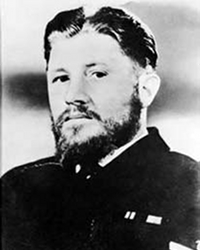Chief Petty Officer Jonathan Rogers

Jonathan Rogers was born on 16 September 1920 at Froncysyllte, near Llangollen, Denbighshire, Wales, fifth of seven children of Jonathan Rogers, labourer, and his wife Sarah Ellen, née Probyn. Leaving Acrefair Central School at the age of 14, he worked at the Ruabon brickyard, boxed and played soccer.
On 22 November 1938 Rogers enlisted in the Royal Navy. Five foot 8 inches (173cm) tall and heavily built, he had brown hair, blue eyes and a fresh complexion. He spent most of World War II at sea in three coastal vessels: Motor Anti-Submarine Boat No. 62 (1940-41), Motor Launch No. 204 (1942-43) and Motor Torpedo Boat No. 698 (1943-45). Promoted Petty Officer in 1943, he was awarded the Distinguished Service Medal for his 'coolness and leadership' under enemy fire during an action off Dunkirk, France, on the night of 23/24 May 1944. He was discharged from the RN on 23 January 1946.
At the parish church, Pen-y-cae, Denbighshire, on 4 April 1942 Rogers had married Lorraine Williams; they lived in the village and were to have four children. After the war he worked above ground at a local colliery and built pre-fabricated houses. In 1950 he applied to join the Royal Australian Navy. He was accepted on 6 July and posted to the aircraft-carrier HMAS Sydney; his next ship was the frigate Burdekin. Service (1952-54) in the destroyer Tobruk took him to Korean waters. He was promoted Chief Petty Officer in 1956. His subsequent postings included the ships Junee (1956-57), Anzac (1957-58), Warramunga (1959) and Barcoo (1959-61), and the shore establishments Cerberus (1958-59), Westernport, Victoria, and Rushcutter (1961-62), Sydney. The family finally settled at Ettalong Beach, New South Wales.
In January 1963 'Buck' Rogers joined the destroyer Voyager which was commanded by Captain DH Stevens. As her coxswain, Rogers was the senior sailor on board and responsible for the 'good order and discipline' of the ship's company. On 10 February 1964 Voyager took part in exercises with the aircraft-carrier Melbourne off the south coast of New South Wales. That evening Rogers presided over a game of tombola being played by about sixty men in the ship's forward cafeteria. At 20:56, 20 nautical miles (37km) south-east of Jervis Bay, Voyager collided with Melbourne and was cut in two. Voyager's severed forward section immediately heeled sharply to starboard and about five minutes later turned upside down. Water began pouring into the cafeteria. Within another five minutes the forward section sank. Rogers was one of the 82 men who died. His wife, son and three daughters survived him.
http://seapower.navy.gov.au/hmas-voyager-ii
Sailors who escaped from the cafeteria later told how Rogers had taken charge of the situation. He had calmed terrified shipmates, attempted to control the flooding, tried to free a jammed escape hatch with a length of pipe and a spanner, and organised men to move into other compartments with functioning emergency exits. Meanwhile, he knew that he was probably too large to fit through an escape hatch himself. When it was obvious that some of his comrades would not get out in time, he led them in prayer and a hymn, 'encouraging them to meet death' beside him 'with dignity and honour'. His wife remarked: 'It was typical of him - he never thought of himself'. He was posthumously awarded the George Cross.
Source: http://adb.anu.edu.au/biography/rogers-jonathan-11557



